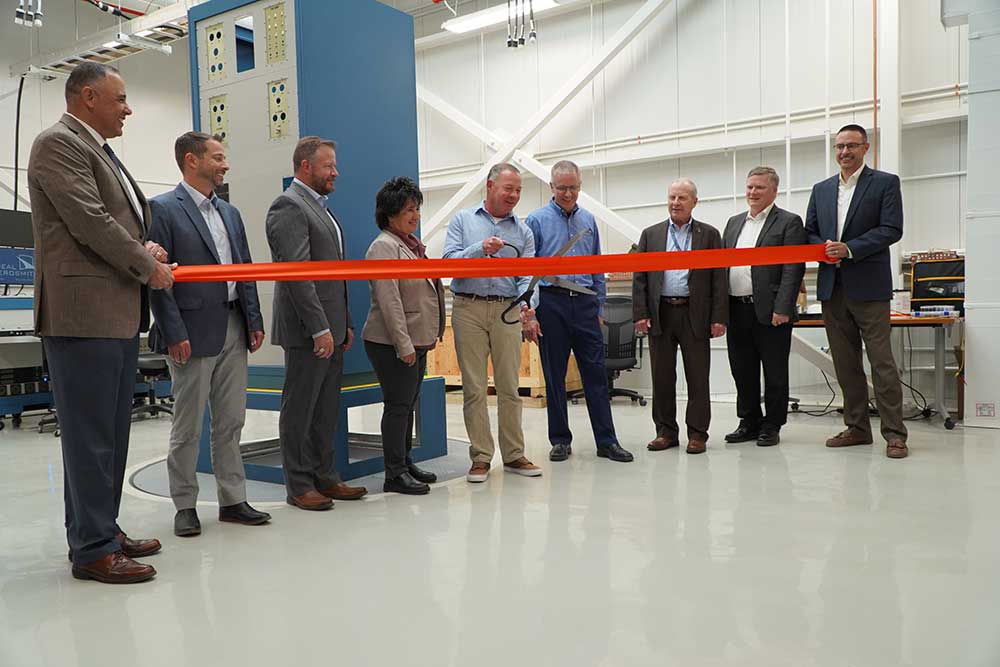WETL celebrates completion of new centrifuge

In 1893, Amarillo, Texas, was listed as a place with “between 500 and 600 humans and 50,000 head of cattle.” Today, with a steady population of over 300,000 — and still a large number of cattle — it is home to Sandia’s Weapons Evaluation Test Laboratory, a gem in the nuclear security enterprise with greater capabilities on the horizon.
On Oct. 2, visitors from across the country gathered at the WETL to attend the ribbon-cutting of a new centrifuge that will enable Sandia to perform more nonnuclear testing in a shorter timeframe.
On the day of the ribbon cutting, visitors were met with a palpable buzz of excitement. Hands were shaken and introductions were made. Speakers took their spots and cameras were set. WETL manager Larry Kuykendall was center stage.
Larry was part expert and part host, greeting guests and answering technical questions. “Ribbon cuttings are rare ’round here,” he said with pride.
WETL is DOE’s only laboratory with two centrifuges that support full system-level testing; it has been housed in Amarillo, within the Pantex plant, since its inception in 1964. WETL is responsible for performing nonnuclear testing and evaluation of every weapon system in the U.S. nuclear arsenal.
And those responsibilities are always evolving. “We’re expanding our workload to prepare for new systems, such as the W93,” Larry said, further necessitating two working centrifuges at all times.
Reflecting on why so many were gathered to celebrate a new centrifuge, Jared McLaughlin, senior manager of the Integrated Stockpile Evaluation group, said, “If it’s a nuclear weapon, it has to be tested. And there is no shortage of work.”
A big job for a small team
Before unfurling the red ribbon and breaking out the ceremonial scissors, visitors from NNSA, Sandia, Pantex and elsewhere were treated to a presentation that answered the “why” of it all.
All weapon types in the active and inactive stockpile must be regularly tested to continue assessment of the safety and reliability of the stockpile. Weapons are pulled from the stockpile, disassembled and tested. Data collected informs the Annual Assessment Report, which eventually lands on the desk of the president, assuring the nation of the safety and effectiveness of the country’s nuclear weapons arsenal.
Additionally, modernization program systems are tested when parts are qualified or as systems enter the stockpile. It’s a big job for a remarkably dedicated team of 36 Sandians, which is double the staff from 20 years ago.
WETL’s centrifuge capabilities include simulating acceleration and deceleration for mission flight profiles. For example, submarine-launched ballistic missiles come up in a bubble, with steep acceleration and deceleration due to the ejection event. “Our centrifuges can simulate these unique transient events,” Larry said.
Testing capabilities like this make the WETL’s centrifuges indispensable to the nation. So, in 2012, when one of the two centrifuges broke down, causing a backlog of work, the seed was sown for improvements.
Partnership was key to success


ALL SYSTEMS GO — Visitors traveled from across the U.S. to attend the ribbon-cutting at the Weapons Evaluation Test Laboratory, including, from left, Chris O’Gorman, Sandia director of Weapons Stockpile Management; Jason Meyer, NNSA director of the Office Of Stockpile Sustainment; Jeff Heath, Sandia associated Labs director of Infrastructure Operations; Rita Gonzales, Sandia associate Labs director of Nuclear Deterrence; Larry Kuykendall, WETL manager; Robert Krack, Ideal Aerosmith sales application engineer; Steve Girrens, Sandia associate Labs director for Stockpile Management, Components and Production; Joe Gazda, NNSA deputy assistant deputy administrator of the Office of Stockpile Management; and Jared McLaughlin, Sandia senior manager of the Integrated Stockpile Evaluation group. (Photo by Justin Griffin)
While teams worked on repairs, Sandia leaders worked with partners at NNSA to devise a plan to install a new centrifuge. In November 2022, Summit Construction broke ground to make room for the new equipment, about the same time that Ideal Aerosmith began building a centrifuge to meet weapon system surveillance requirements.
Tanya Chavez-Cropp, manager of the Ballistic Missile Tester Development group, emphasized the criticality of partnering with NNSA and Ideal Aerosmith.
“This whole team was very committed to the best outcome,” she said. “It took a great amount of partnership, not only to modify and expand the building, but to design and install a large centrifuge safely and ensure it worked as intended. I’m very proud of everyone involved in this effort — it truly exemplifies partnering to succeed.”
The new centrifuge not only provides additional capacity but incorporates slip-ring technology that significantly improves data acquisition.
The entire project was completed in October, and while it will take about six months to qualify the new centrifuge, there is no time for rest.
“With more modernization programs transitioning to the stockpile, we are booked solid. All systems go,” Jared said.
Spinning into the future
To help with added work, NNSA has approved a future expansion project to add 4,000 square feet to WETL to house new equipment for testing W80-4, W87-1 and other programs.
“Every weapon has its own unique testing and collection equipment, so we need more room,” Larry said.
Since WETL needs two centrifuges up and always running, once the new centrifuge is ready for work, the two existing centrifuges will each, in turn, be replaced.
And so, on that day in October, a group of key project stakeholders gathered around Larry and watched as he cut the ribbon symbolizing the future of the facility and the continued dedication in a strong national nuclear deterrence posture.
When asked what has kept him at WETL for 25 years, Larry said something many Sandians have said over their career at the Labs: “I believe in our mission, and I have a lot of pride in what we do.”
Indeed, WETL was filled with pride that day — something that will fuel the vital work there for decades to come.